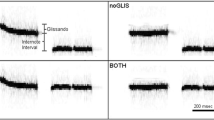Abstract
In a two-alternative forced-choice procedure lesser spear-nosed bats, Phyllostomus discolor, had to discriminate between a pure tone stimulus and a sinusoidally frequency-modulated signal generated at the same carrier frequency as the tone. Modulation depths of the SFM stimuli were reduced until the animals' performance dropped below the 75%-correct level which was used to determine difference limens for detection of frequency modulation (FMDL). The dependence of FMDLs on modulation and carrier frequency was systematically investigated. For a carrier frequency of 18.5 kHz, average FMDLs increased from 95 Hz at a modulation frequency of 10 Hz to 820 Hz at a modulation frequency of 2000 Hz which corresponds to Weber ratios (2Δf/f) of 0.005 and 0.044 respectively. Further, difference limens were found to increase linearly in proportion to carrier frequency throughout a major part (9–74 kHz) of the species' hearing range. In comparison to other mammals, P. discolor has a pronounced capability for frequency discrimination which might be related to the extensive use of individually distinct frequency-modulated communication calls and audio-vocal learning.
Similar content being viewed by others
Abbreviations
- FM :
-
frequency modulation
- SFM :
-
sinusoidal frequency modulation
- FMDL :
-
frequency modulation difference limen
- CF :
-
constant frequency
- DLF :
-
difference limen for frequency
- VCO :
-
voltage-controlled oscillator
- SPL :
-
sound pressure level
- WR :
-
Weber ratio
References
Bartsch E, Schmidt S (1992) Frequency modulation thresholds in the free-tailed bat, Tadarida brasiliensis. In: Elsner N, Richter DW (eds) Rhythmogenesis in neurons and networks. Thieme, Stuttgart, pp 231
Bartsch E, Schmidt S (1993) Psychophysical frequency modulation thresholds in a FM-bat, Tadarida brasiliensis. Hearing Res 67: 128–138
Ehret G (1975) Frequency and intensity difference limens and non-linearities in the ear of the housemouse (Mus musculus). J Comp Physiol 102: 321–336
Ehret G (1977) Comparative psychoacoustics: perspectives of peripheral sound analysis in mammals. Naturwissenschaften 64: 461–470
Emde G von der, Menne D (1989) Discrimination of insect wingbeat-frequencies by the bat Rhinolophus ferrumequinum. J Comp Physiol A 164: 663–671
Emde G von der, Schnitzler H-U (1986) Fluttering target detection in Hipposiderid bats. J Comp Physiol A 159: 765–772
Emde G von der, Schnitzler H-U (1990) Classification of insects by echolocating greater horseshoe bats. J Comp Physiol A 167: 423–430
Emmons LH, Feer F (1990) Neotropical rainforest mammals: a field guide. The University of Chicago Press, Chicago
Esser K-H (1994) Audio-vocal learning in a non-human mammal: the lesser spear-nosed bat Phyllostomus discolor. NeuroReport 5: 1718–1720
Esser K-H, Daucher A (1996) Hearing in the FM-bat Phyllostomus discolor: a behavioral audiogram. J Comp Physiol A 178: 779–785
Esser K-H, Schmidt U (1989) Mother-infant communication in the lesser spear-nosed bat Phyllostomus discolor (Chiroptera, Phyllostomidae) — evidence for acoustic learning. Ethology 82: 156–168
Esser K-H, Schmidt U (1990) Behavioral auditory thresholds in neonate lesser spear-nosed bats, Phyllostomus discolor. Naturwissenschaften 77: 292–294
Fay RR (1974) Auditory frequency discrimination in vertebrates. J Acoust Soc Am 56: 206–209
Fay RR (1988) Hearing in vertebrates: a psychophysics databook. Hill-Fay Associates, Winnetka, Illinois
Feng AS, Condon CJ, White KR (1994) Stroboscopic hearing as a mechanism for prey discrimination in frequency-modulated bats? J Acoust Soc Am 95: 2736–2744
Fenton MB (1985) Communication in the Chiroptera. Indiana University Press, Bloomington
Heffner R, Heffner H, Masterton B (1971) Behavioral measurements of absolute and frequency-difference thresholds in guinea pig. J Acoust Soc Am 49: 1888–1895
Heilmann-Rudolf U (1984) Das Frequenzunterscheidungsvermögen bei der Großen Hufeisennase Rhinolophus ferrumequinum. PhD thesis, Eberhard-Karls-University Tübingen, Tübingen (FRG)
Herman LM, Arbeit WR (1972) Frequency difference limens in the bottlenose dolphin: 1–70 KC. J Aud Res 2: 109–120
Keidel WD (1975) Physiologie des Gehörs. Thieme, Stuttgart
Long GR (1994) Psychoacoustics. In: Fay RR, Popper AN (eds) Comparative hearing: mammals. Springer, New York, pp 18–56
Moore BCJ (1993) Frequency analysis and pitch perception. In: Yost WA, Popper AN, Fay RR (eds) Human psychophysics. Springer, New York, pp 56–115
Neuweiler G (1962) Bau und Leistung des Flughundauges (Pteropus giganteus gig. Brünn.). Z Vergl Physiol 46: 13–56
Neuweiler G (1970) Neurophysiologische Untersuchungen zum Echoortungssystem der Großen Hufeisennase, Rhinolophus ferrumequinum. Z Vergl Physiol 67: 273–306
Neuweiler G (1990) Auditory adaptations for prey capture in echolocating bats. Physiol Rev 70: 615–641
Neuweiler G, Fenton MB (1988) Behaviour and foraging ecology of echolocating bats. In: Nachtigall PE, Moore PWB (eds) Animal sonar: processes and performance. Plenum Press, New York, pp 535–549
Penner MJ (1995) Psychophysical methods. In: Klump GM, Dooling RJ, Fay RR, Stebbins WC (eds) Methods in comparative psychoacoustics. Birkhäuser, Basel, pp 47–57
Pollak GD, Casseday JH (1989) The neural basis of echolocation in bats. Springer, Berlin Heidelberg New York
Roverud RC (1994) Complex sound analysis in the lesser bulldog bat: evidence for a mechanism for processing frequency elements of frequency modulated signals over restricted time intervals. J Comp Physiol A 174: 559–565
Roverud RC, Rabitoy ER (1994) Complex sound analysis in the FM bat Eptesicus fuscus, correlated with structural parameters of frequency modulated signals. J Comp Physiol A 174: 567–573
Schnitzler H-U, Flieger E (1983) Detection of oscillating target movements by echolocation in the greater horseshoe bat. J Comp Physiol 153: 385–391
Schnitzler H-U, Menne D, Kober R, Heblich K (1983) The acoustical image of fluttering insects in echolocating bats. In: Huber F, Markl H (eds) Neuroethology and behavioral physiology. Springer, Berlin Heidelberg New York, pp 235–250
Sum YW, Menne D (1988) Discrimination of fluttering targets by the FM-bat Pipistrellus stenopterus. J Comp Physiol A 163: 349–354
Yost WA, Sheft S (1993) Auditory perception. In: Yost WA, Popper AN, Fay RR (eds) Human psychophysics. Springer, New York Berlin Heidelberg, pp 193–236
Zwicker E, Fast H (1990) Psychoacoustics: facts and models. Springer, Berlin Heidelberg New York
Author information
Authors and Affiliations
Rights and permissions
About this article
Cite this article
Esser, K.H., Kiefer, R. Detection of frequency modulation in the FM-bat Phyllostomus discolor . J Comp Physiol A 178, 787–796 (1996). https://doi.org/10.1007/BF00225827
Accepted:
Issue Date:
DOI: https://doi.org/10.1007/BF00225827




